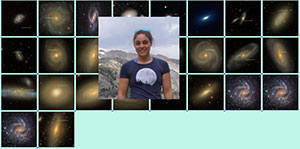UW Planetarium Explores Star Formation, 2017 Eclipse During May Programs
Published April 27, 2021

Activities at the University of Wyoming Harry C. Vaughan Planetarium may start slowly during May, but they will soon pick up speed like a hurtling comet.
Scheduled highlights include a talk by Jessica Sutter, a UW Ph.D. student in physics, who will share her research on star formation in nearby galaxies with the public May 14; a program on the 2017 eclipse for which Wyoming was a prime viewing spot; and an event not even on the planetarium schedule.
“The highlight of astronomical activity for this month will be a total lunar eclipse visible in the early morning hours -- 3:45-5:30 a.m. -- of May 26,” says Max Gilbraith, the planetarium’s coordinator. “We don’t have any public events scheduled just yet, but check back with us if we receive enough interest to open the observatory. Lunar eclipses are slow events and take a bit of patience to enjoy.”
Over the course of several hours, the full moon will pass into the Earth’s shadow, causing it to darken and subsequently redden as the red component of sunlight bends through our atmosphere to reach the lunar surface, Gilbraith explains. The eclipse will not reach totality as seen from Laramie, as the moon will set around 5:15 a.m. in the southwest, he adds.
“It’s best enjoyed with a pair of binoculars or low-power telescope,” Gilbraith says. “Let’s hope for clear skies that morning.”
A film and special live talk for audiences will be featured each week. The planetarium will be closed Sunday through Friday, May 2-7, but will be available for private shows.
Seating is limited, so tickets will be by reservation only. To get tickets or receive more information about programs, email planetarium@uwyo.edu or leave a voicemail and a call-back phone number at (307) 766-6506. Tickets are $5 for the public and $3 for students and those under 18. Cash or check is accepted at the door. The planetarium, which seats 58, is located in the basement of the Physical Sciences Building.
The May schedule is as follows:
-- Full-dome movie: “Dawn of the Space Age,” Saturday, May 1, 2 p.m. From the launch of the first artificial satellite, Sputnik, to the magnificent lunar landings and privately operated space flights, the audience will be immersed and overwhelmed with this most accurate historic reconstruction of man’s first steps into space.
-- Full-dome movie: “Cosmic Origins Spectrograph,” Saturday, May 8, 2 p.m. This 30-minute film highlights the current research of Cosmic Origins Spectrograph (COS) aboard the Hubble Space Telescope, the last instrument installed by the NASA astronauts. COS allows an unprecedented view into the vast spaces between galaxies that surround the Milky Way. The presentation will be followed by a live lecture, question-and-answer session and a star talk.
-- “Wyoming Skies,” Tuesdays, May 11 and 25, 7 p.m. This program provides an exploration of the stars, constellations, planets and other celestial phenomena visible from Laramie for the season.
-- “Star Formation in Local Galaxies,” Friday, May 14, 7 p.m. Special guest Jessica
Sutter, a UW Ph.D. student in physics, will use data from the KINGFISH (Key Insights
on Nearby Galaxies: A Far-Infrared Survey with Herschel) to explain how galaxies grow
by looking at newborn stars in both nearby and extremely distant galaxies.
-- Full-dome movie: “SEEING!,” Saturday, May 15, 2 p.m. This film follows a photon’s
creation and journey across the galaxy to a young stargazer’s eye. The viewer follows
the photon into the girl’s eye, learning the structures of the eye and their functions,
before taking a ride on the optic nerve.
-- “Great American Eclipse of 2017,” Friday, May 21, 7 p.m. Relive and celebrate the eclipse of 2017 that passed through Wyoming. This program will share full-dome images of the eclipse captured from the ground and air, and explore the science of eclipses.
-- Full-dome movie: “Back to the Moon for Good,” Saturday, May 22, 2 p.m. This film opens with the first era of space exploration in the late 1960s and early 1970s. Viewers will learn what that era of landers and orbiters taught about the moon, including the discovery of its origin, composition, structure and the accessibility of raw materials on its surface. The Google Lunar XPRIZE, designed to democratize space and create new opportunities for eventual human and robotic presence on the moon, also will be covered.
-- “The Stellar Graveyard: From White Dwarfs to Supermassive Black Holes,” Friday, May 28, 7 p.m. This program provides an exploration of the beautiful, bizarre and potentially dangerous remains of stars across our galaxy and the universe. The program will cover the innovative techniques to observe them and the mind-blowing physics involved.
-- Full-dome movie: “IBEX: Search for the Edge of the Solar System,” Saturday, May 29, 2 p.m. Join scientists who are investigating the boundary between our solar system and the rest of the galaxy. This film follows the creation of NASA’s Interstellar Boundary Explorer (IBEX). The audience will get an in-depth look at the mission and how IBEX is collecting high-speed atoms to create a map of our solar system’s boundary.
All programs are about an hour in length. As time allows, a portion of the show also may focus on a live sky tour or supporting information related to the film’s topic.
“In addition to our public events, we do have a number of field trip and outreach events at the planetarium and visiting locations,” Gilbraith says. “We have multiple star parties planned where we’ll be taking some telescopes on-site with schools and other learning programs. Don’t hesitate to call us to schedule a visit to our planetarium or observatory, or to have us visit you with telescopes or science activities.”
If you have a group larger than six, it is recommended to contact the planetarium for a private show, Gilbraith says. The rate for private shows is the same as ticket prices for public shows.

